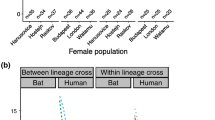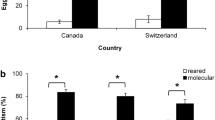Abstract
Populations of bed bugs, Cimex lectularius, have increased in recent years spreading into numerous urban areas across the Western world and making them an increasingly important pest of the twenty-first century. Research into hybridization within and between different lineages of bed bugs can help us to understand processes of micro- and macro-evolution in these ectoparasites and may inform the control of this pest species. Hybridization experiments between two host lineages of bed bug (C. lectularius) from Central Europe (Czech Republic), those associated with humans and those with bats, were conducted under laboratory conditions. Number of eggs and early instars were compared between crosses of mixed host lineages (interspecific mating) with pairs from the same host lineage, those from the same locality and same lineage from different localities (intraspecific mating). While crosses within host lineages resulted in egg production and later instars, crosses between different host lineages were unsuccessful, although of the mated females possessed sperm in their mesospermaleges and/or seminal conceptacles. These crosses did not even result in egg production. Moreover, in the mixed lineage crosses, mortality rates in adults were higher (51 and 50 % higher in bat and human lineage, respectively) than in those animals from the same lineage. Survival of adults was in pairs from the same locality slightly higher than in pairs from different localities and differed statistically. These results support the existence of post-mating barriers and show reproductive isolation between two lineages of C. lectularius. Bat and human host adaptations can promote evolving of such barriers and can be product of alloxenic speciation.

Similar content being viewed by others
References
Arkwright JA, Atkin EE, Bacot A (1921) An autoradiographic investigation of sperm movements in the female reproductive tract. Proc R Soc Lond B Biol Sci 263:369–376
Arnold ML (1992) Natural hybridization as an evolutionary process. Annu Rev Ecol Syst 23:237–261
Arnqvist G, Rowe L (2005) Sexual conflict. Princeton Univ Press, Princeton
Baker AM, Shore JS (2005) Pollen competition in Turnera ulmifolia (Turneraceae). Am J Bot 82:171–725
Baldo L, Hotopp JCD, Jolley KA, Bordenstein SR, Biber SA, Chounhurry RR, Hayashi C, Maiden MCJ, Tettelin H, Werren JH (2006) Multilocus sequence typing system for the endosymbiont Wolbachia pipientis. Appl Environ Microbiol 72:7098–7110
Balvín O, Munclinger P, Kratochvíl L, Vilímová J (2012) Mitochondrial DNA and morphology show independent evolutionary histories of bed bug Cimex lectularius (Heteroptera: Cimicidae) on bats and humans. Parasitol Res 111:457–469
Bishop JDD (1996) Female control of paternity in the internally fertilizing compound ascidian Diplosoma listerianum. I. Autoradiographic investigation of sperm movements in the female reproductive tract. Proc R Soc Lond B Biol Sci 263:369–376
Booth W, Balvín O, Vargo EL, Vilímová J, Schal C (2015) Host association drives genetic divergence in the bed bug, Cimex lectularius. Mol Ecol. doi:10.1111/mec.13086
Brooks DR, McLennan DA (1993) Parascript: parasites and the language of evolution. Smithsonian Institution Press, Washington, DC
Carayon J (1966) Paragenital system. In: Usinger RL (ed) Monograph of Cimicidae (Hemiptera–Heteroptera). College Park, MD: Thomas Say Foundation, Entomol Soc of Amer, pp 81–166
Coetzee M, Hunt RH, Walpole DE (1995) Interpretation of mating between two bedbug taxa in a zone of sympatry in KwaZulu, South Africa. In: Lambert DH, Spenzer HG (eds) Speciation and the recognition concept: theory and application. Johns Hopkins University Press, Baltimore, pp 175–190
Combes C, Théron A (2000) Metazoan parasites and resource heterogeneity: constraints and benefits. Int J Parasitol 30:299–304
Coyne JA, Orr HA (2004) Speciation. Sinauer, Sunderland
Davis NT (1965) Studies of the reproductive physiology of Cimicidae (Hemiptera). II. Artificial insemination and the function of seminal fluid. J Insect Physiol 11:355–366
Detwiler JT, Criscione CD (2010) An infectious topic in reticulate evolution: introgression and hybridization in animal parasites. Genes 1, doi: 102–12310.3390/genes1010102
Drès M, Mallet J (2002) Host races in plant-feeding insects and their importance in sympatric speciation. Philos Trans R Soc Lond B 357:471–492
Eady PE (2001) Postcopulatory, prezygotic reproductive isolation. J Zool 253:47–52
Eberhard WG (1996) Female control: sexual selection by cryptic female choice. Princeton Univ Press, Princeton
Eberhard WG (1985) Sexual selection and animal genitalia. Harvard Univ Press, Cambridge
Euzet L, Combes C (1980) Les problèmes de l’espèce chez les animaux parasites. Bull Soc Zool France 40:239–285
Fleur ECC, Wedell N (2006) Wolbachia infection reduces sperm competitive ability in an insect. Proc R Soc B 273:1455–1458
Gregory PG, Howard DJ (1993) Laboratory hybridization studies of Allonemobius fasciatus and A. socius (Orthoptera: Gryllidae). Ann Entomol Soc Am 86:694–701
Harraca V, Ryne C, Ignell R (2010) Nymphs of the common bed bug (Cimex lectularius) produce anti-aphrodisiac defence against conspecific males. BMC Biol 8:121. doi:10.1186/1741-7007-8-121
Holman L, Kokko H (2014) Local adaptation and the evolution of female choice. In: Hunt J, Hosken D (eds) Genotype-by-Environment Interactions and Sexual Selection. Wiley - Blackwell, Hoboken, NJ, pp 41–62
Howard DJ, Palumbi SR, Birge LM, Manier MK (2009) Sperm and speciation. In: Birkhead TR, Hosken DJ, Pitnick S (eds) Sperm biology: an evolutionary perspective. Academic, London, pp 368–403
Hypsa V, Aksoy S (1997) Phylogenetic characterization of two transovarially transmitted endosymbionts of the bed bug Cimex lectularius (Heteroptera: Cimicidae). Insect Mol Biol 6:301–304
Jeyaprakash A, Hoy MA (2000) Long PCR improves Wolbachia DNA amplification: wsp sequences found in 76 % of sixty-three arthropod species. Insect Mol Biol 9:393–405
Johnson CG (1939) Taxonomic characters, variability and relative growth in Cimex lectularius L. and C. columbarius Jenyns (Heteropt. Cimicidae). Trans R Entomol Soc Lond 89:543–568
Katakura H, Sobu H (1986) Cause of low hatchability by the interspecific mating in a pair of sympatric ladybirds (Insecta, Coleoptera, Coccinellidae): incapacitation of alien sperm and death of hybrid embryos. Zool Sci 3:315–322
Knowlton N, Greenwell SR (1984) Male sperm competition avoidance mechanisms: the influence of female interests. In: Smith RL (ed) Sperm competition and the evolution of animal mating system. Academic, London, pp 61–84
Krueger L (2000) Don’t get bitten by the resurgence of bed bugs. Pest Control 68:58–64
Lanier GN, Birch MC, Schmitz RF, Furniss MM (1972) Pheromones of Ips pini (Coleoptera: Scolytidae): variation in response among three populations. Can Entomol 104:1917–1923
Levinson HZ, Ilan Bar AR (1971) Assembling and alerting scents produced by the bed bug, Cimex lectularius L. Experientia 27:102–103
Marx R (1955) Über die Wirtsfindung und die Bedeutung des artspezifischen Duftstoffes bei Cimex lectularius Linné. Parasitol Res 17:41–72
Mashiko K (1992) Genetic egg and clutch size variations in freshwater prawn populations. Oikos 63:454–458
Mayr E (1963) Animal species and evolution. Harvard Univ Press, Cambridge
Mehlhorn H (2008) Encyclopedia of parasitology, 3rd edn. Springer, Berlin
Merrell DJ (1981) Ecological genetics. Univ of Minnesota Press, Minneapolis
Muller HJ (1942) Isolating mechanisms, evolution and temperature. Biopolym Symp 6:71–125
Nosil P (2007) Divergent host plant adaptation and reproductive isolation between ecotypes of Timema cristinae walking sticks. Am Nat 169:151–162
Nosil P, Vines TH, Funk DJ (2005) Perspective: reproductive isolation caused by natural selection against immigrants from divergent habitats. Evolution 59:705–719
Omori N (1939) Experimental studies on the cohabitation and crossing of two species of bed-bugs (Cimex lectularius L. and C. hemipterus F.) and on the effects of interchanging of males of one species for the other, every alternate days upon the fecundity and longevity of females of each species. Act J Med Trop 1:127–154
Omori N (1941) Comparative studies on the ecology and physiology of common and tropical bed bugs, with special reference to the reactions to temperature and moisture. J Med Assoc Taiwan 60:555–729
Poulin R (2007) Evolutionary ecology of parasites, 2nd edn. Princeton Univ Press, New Jersey
Rasgon JL, Scott TW (2004) Phylogenetic characterization of Wolbachia symbionts infecting Cimex lectularius L. and Oeciacus vicarius Horvath (Hemiptera: Cimicidae). J Med Entomol 41:1175–1178
Shapiro LH (2001) Asymmetric assortative mating between two hybridizing Orchelium katydids (Orthoptera: Tettigoniidae). Am Midl Nat 145:423–427
Siva-Jothy MT (2006) Trauma, disease and collateral damage: conflict in cimicids. Philos Trans R Soc B 361:269–275
Siva-Jothy MT, Stutt AD (2003) A matter of taste: direct detection of mating status in the bed bug. Proc R Soc B 270:649–652
Stutt AD, Siva-Jothy MT (2001) Traumatic insemination and sexual conflict in the bed bug Cimex lectularius. Proc Natl Acad Sci U S A 98:5683–5687
Titschack E (1949) Die bettwanze und die taubenwanze. Verh dt Ges angew Entomol 11:71–77
Tyler F, Harrison XA, Bretman A, Veen T, Rodríguez-Muñoz R, Tregenza T (2013) Multiple post-mating barriers to hybridization in field crickets. Mol Ecol 22:1640–1649
Ueshima N (1964) Experiments on reproductive isolation in Cimex lectularius and Cimex columbarius. Pan Pac Entomol 40:47–53
Usinger RL (1966) Monograph of Cimicidae: (Hemiptera-Heteroptera). Thomas Say Foundation, Entomol Soc of Amer, New York
Wade MJ, Patterson H, Chang NW, Johnson NA (1994) Postcopulatory, prezygotic isolation in flour beetles. Heredity 72:163–167
Wawrocka K, Bartonička T (2013) Two different lineages of bed bug (Cimex lectularius) reflected in host specificity. Parasitol Res 112:3897–3904
Wheeler QD, Meier R (2000) Species concept and phylogenetic theory: a debate. Columbia Univ Press, New York
Wilson N, Tubman SC, Eady PE, Robertson GW (1997) Female genotype affects male success in sperm competition. Proc Biol Sci 264:1491–1495
Zeh JA, Zeh DW (1997) The evolution of polyandry II: post-copulatory defences against genetic incompatibility. Proc R Soc Lond B Biol Sci 264:69–75
Acknowledgments
We are very grateful to John Haddow and Henry Schofield for their valuable comments on the manuscript and Martin Toman and Zdeněk Buřič for their help with fieldwork and sampling bed bugs.
Author information
Authors and Affiliations
Corresponding author
Rights and permissions
About this article
Cite this article
Wawrocka, K., Balvín, O. & Bartonička, T. Reproduction barrier between two lineages of bed bug (Cimex lectularius) (Heteroptera: Cimicidae). Parasitol Res 114, 3019–3025 (2015). https://doi.org/10.1007/s00436-015-4504-1
Received:
Accepted:
Published:
Issue Date:
DOI: https://doi.org/10.1007/s00436-015-4504-1




